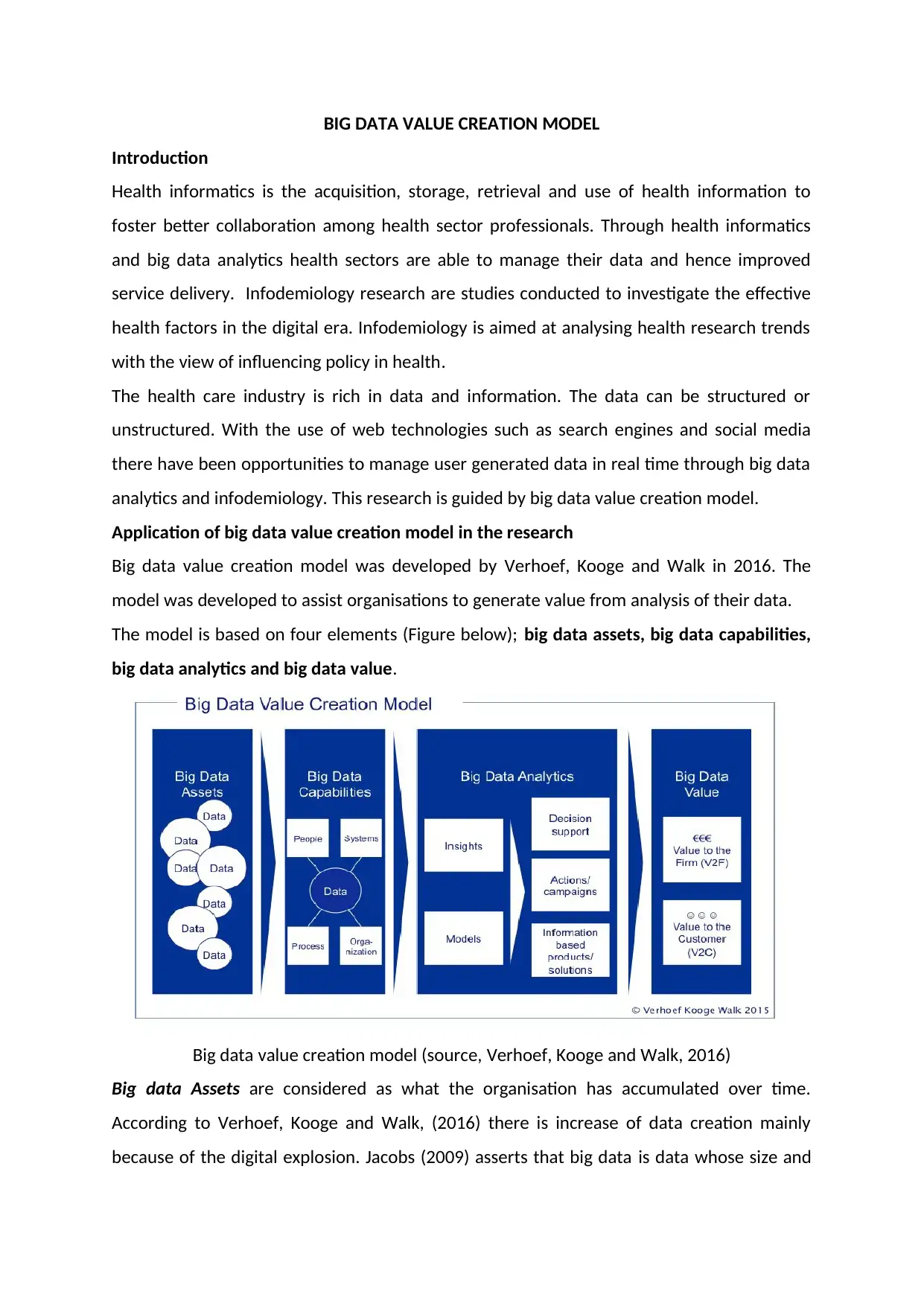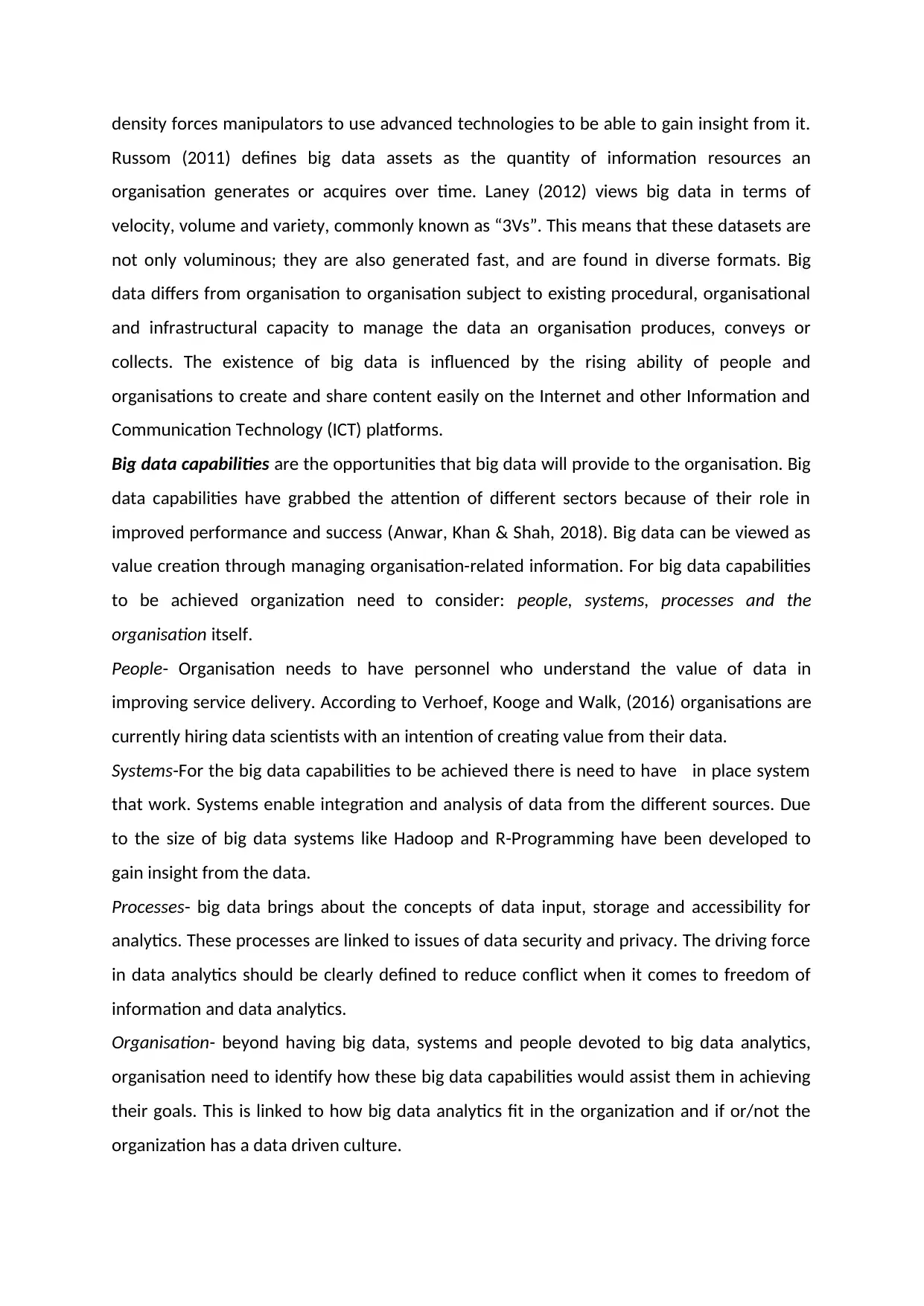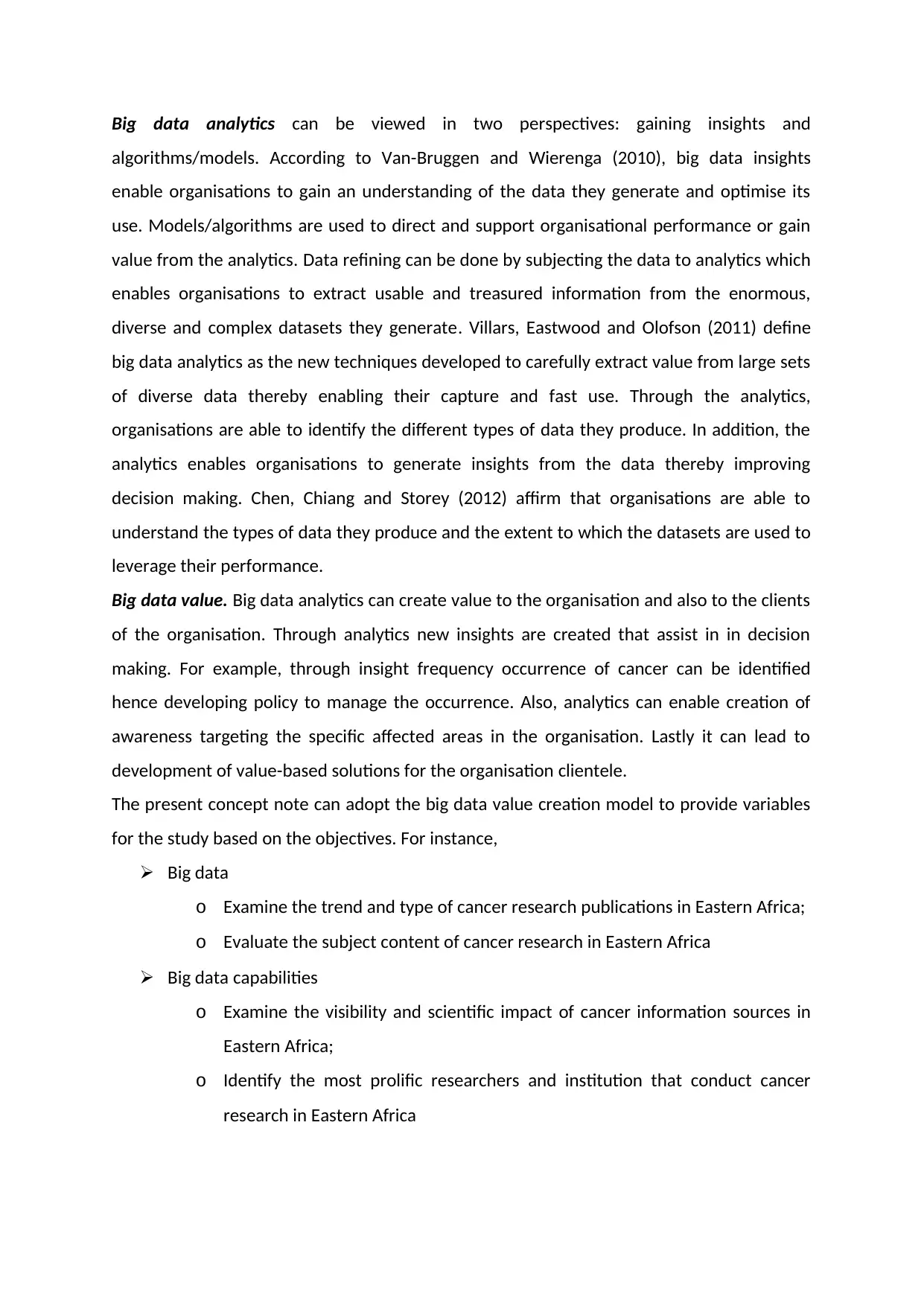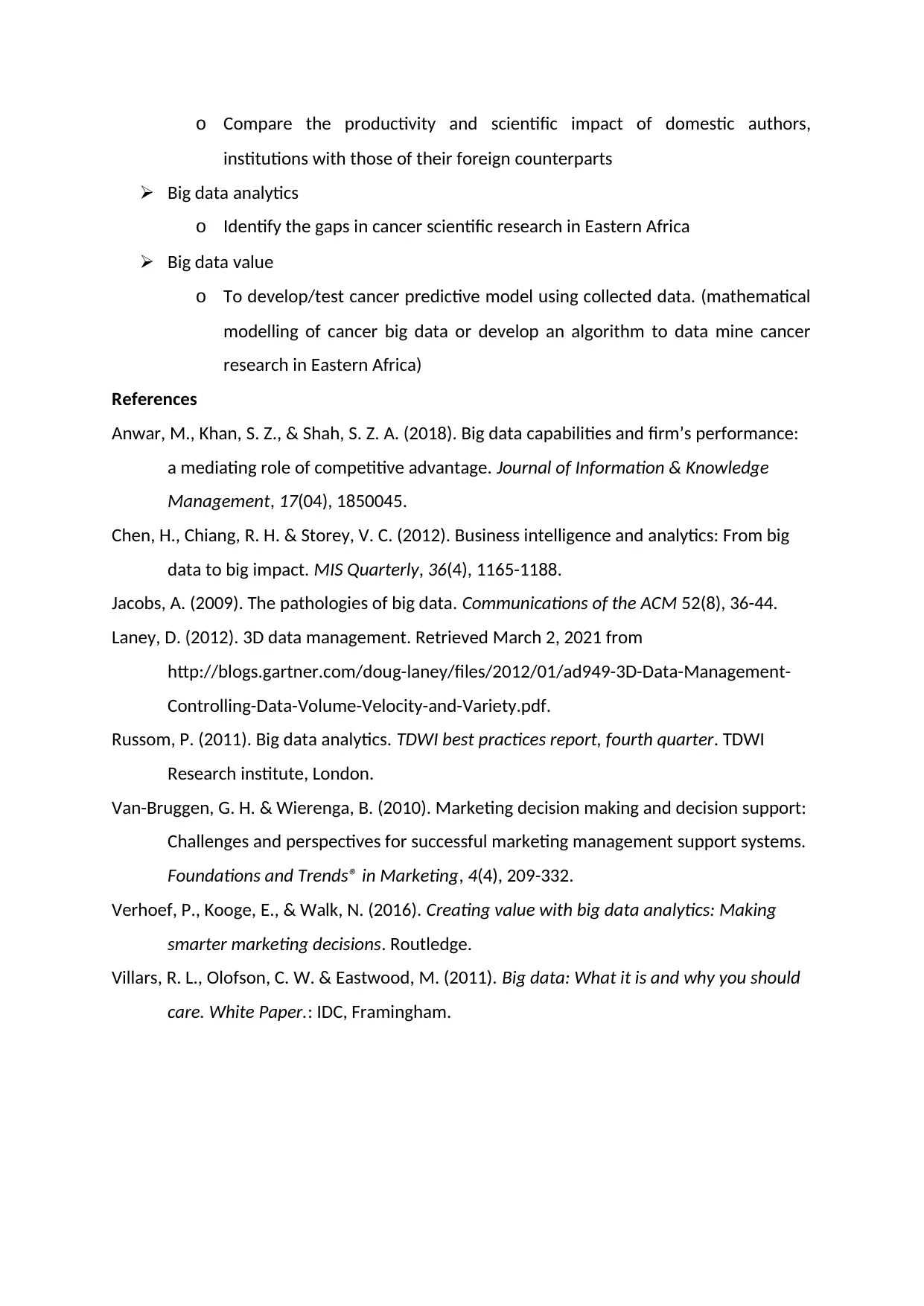Big Data Value Creation Model Application in Cancer Research
VerifiedAdded on 2022/02/21
|5
|1441
|44
Report
AI Summary
This report provides an in-depth analysis of the Big Data Value Creation Model, focusing on its application within the field of health informatics, particularly in the context of cancer research. The report begins with an introduction to health informatics, emphasizing the role of big data analytics and infodemiology in improving healthcare service delivery. The core of the report centers on the Big Data Value Creation Model, which consists of four key elements: big data assets, big data capabilities, big data analytics, and big data value. The report defines and elaborates on each of these elements, drawing on existing literature to explain how organizations can leverage data to generate value. The report explores big data assets, detailing how organizations accumulate data, and discusses big data capabilities, emphasizing the importance of people, systems, processes, and organizational alignment. Big data analytics are examined, highlighting the role of insights and algorithms in extracting value from data. Finally, the report discusses how big data analytics can create value for both organizations and their clients, offering examples such as identifying cancer trends and developing predictive models. The report concludes by outlining how the Big Data Value Creation Model can be applied to a specific cancer research study, suggesting variables based on research objectives.

NO. NAME REGISTRATION NUMBER SIGN.
1. Lucy Kibe
1. Lucy Kibe
Paraphrase This Document
Need a fresh take? Get an instant paraphrase of this document with our AI Paraphraser

BIG DATA VALUE CREATION MODEL
Introduction
Health informatics is the acquisition, storage, retrieval and use of health information to
foster better collaboration among health sector professionals. Through health informatics
and big data analytics health sectors are able to manage their data and hence improved
service delivery. Infodemiology research are studies conducted to investigate the effective
health factors in the digital era. Infodemiology is aimed at analysing health research trends
with the view of influencing policy in health.
The health care industry is rich in data and information. The data can be structured or
unstructured. With the use of web technologies such as search engines and social media
there have been opportunities to manage user generated data in real time through big data
analytics and infodemiology. This research is guided by big data value creation model.
Application of big data value creation model in the research
Big data value creation model was developed by Verhoef, Kooge and Walk in 2016. The
model was developed to assist organisations to generate value from analysis of their data.
The model is based on four elements (Figure below); big data assets, big data capabilities,
big data analytics and big data value.
Big data value creation model (source, Verhoef, Kooge and Walk, 2016)
Big data Assets are considered as what the organisation has accumulated over time.
According to Verhoef, Kooge and Walk, (2016) there is increase of data creation mainly
because of the digital explosion. Jacobs (2009) asserts that big data is data whose size and
Introduction
Health informatics is the acquisition, storage, retrieval and use of health information to
foster better collaboration among health sector professionals. Through health informatics
and big data analytics health sectors are able to manage their data and hence improved
service delivery. Infodemiology research are studies conducted to investigate the effective
health factors in the digital era. Infodemiology is aimed at analysing health research trends
with the view of influencing policy in health.
The health care industry is rich in data and information. The data can be structured or
unstructured. With the use of web technologies such as search engines and social media
there have been opportunities to manage user generated data in real time through big data
analytics and infodemiology. This research is guided by big data value creation model.
Application of big data value creation model in the research
Big data value creation model was developed by Verhoef, Kooge and Walk in 2016. The
model was developed to assist organisations to generate value from analysis of their data.
The model is based on four elements (Figure below); big data assets, big data capabilities,
big data analytics and big data value.
Big data value creation model (source, Verhoef, Kooge and Walk, 2016)
Big data Assets are considered as what the organisation has accumulated over time.
According to Verhoef, Kooge and Walk, (2016) there is increase of data creation mainly
because of the digital explosion. Jacobs (2009) asserts that big data is data whose size and

density forces manipulators to use advanced technologies to be able to gain insight from it.
Russom (2011) defines big data assets as the quantity of information resources an
organisation generates or acquires over time. Laney (2012) views big data in terms of
velocity, volume and variety, commonly known as “3Vs”. This means that these datasets are
not only voluminous; they are also generated fast, and are found in diverse formats. Big
data differs from organisation to organisation subject to existing procedural, organisational
and infrastructural capacity to manage the data an organisation produces, conveys or
collects. The existence of big data is influenced by the rising ability of people and
organisations to create and share content easily on the Internet and other Information and
Communication Technology (ICT) platforms.
Big data capabilities are the opportunities that big data will provide to the organisation. Big
data capabilities have grabbed the attention of different sectors because of their role in
improved performance and success (Anwar, Khan & Shah, 2018). Big data can be viewed as
value creation through managing organisation-related information. For big data capabilities
to be achieved organization need to consider: people, systems, processes and the
organisation itself.
People- Organisation needs to have personnel who understand the value of data in
improving service delivery. According to Verhoef, Kooge and Walk, (2016) organisations are
currently hiring data scientists with an intention of creating value from their data.
Systems-For the big data capabilities to be achieved there is need to have in place system
that work. Systems enable integration and analysis of data from the different sources. Due
to the size of big data systems like Hadoop and R-Programming have been developed to
gain insight from the data.
Processes- big data brings about the concepts of data input, storage and accessibility for
analytics. These processes are linked to issues of data security and privacy. The driving force
in data analytics should be clearly defined to reduce conflict when it comes to freedom of
information and data analytics.
Organisation- beyond having big data, systems and people devoted to big data analytics,
organisation need to identify how these big data capabilities would assist them in achieving
their goals. This is linked to how big data analytics fit in the organization and if or/not the
organization has a data driven culture.
Russom (2011) defines big data assets as the quantity of information resources an
organisation generates or acquires over time. Laney (2012) views big data in terms of
velocity, volume and variety, commonly known as “3Vs”. This means that these datasets are
not only voluminous; they are also generated fast, and are found in diverse formats. Big
data differs from organisation to organisation subject to existing procedural, organisational
and infrastructural capacity to manage the data an organisation produces, conveys or
collects. The existence of big data is influenced by the rising ability of people and
organisations to create and share content easily on the Internet and other Information and
Communication Technology (ICT) platforms.
Big data capabilities are the opportunities that big data will provide to the organisation. Big
data capabilities have grabbed the attention of different sectors because of their role in
improved performance and success (Anwar, Khan & Shah, 2018). Big data can be viewed as
value creation through managing organisation-related information. For big data capabilities
to be achieved organization need to consider: people, systems, processes and the
organisation itself.
People- Organisation needs to have personnel who understand the value of data in
improving service delivery. According to Verhoef, Kooge and Walk, (2016) organisations are
currently hiring data scientists with an intention of creating value from their data.
Systems-For the big data capabilities to be achieved there is need to have in place system
that work. Systems enable integration and analysis of data from the different sources. Due
to the size of big data systems like Hadoop and R-Programming have been developed to
gain insight from the data.
Processes- big data brings about the concepts of data input, storage and accessibility for
analytics. These processes are linked to issues of data security and privacy. The driving force
in data analytics should be clearly defined to reduce conflict when it comes to freedom of
information and data analytics.
Organisation- beyond having big data, systems and people devoted to big data analytics,
organisation need to identify how these big data capabilities would assist them in achieving
their goals. This is linked to how big data analytics fit in the organization and if or/not the
organization has a data driven culture.
⊘ This is a preview!⊘
Do you want full access?
Subscribe today to unlock all pages.

Trusted by 1+ million students worldwide

Big data analytics can be viewed in two perspectives: gaining insights and
algorithms/models. According to Van-Bruggen and Wierenga (2010), big data insights
enable organisations to gain an understanding of the data they generate and optimise its
use. Models/algorithms are used to direct and support organisational performance or gain
value from the analytics. Data refining can be done by subjecting the data to analytics which
enables organisations to extract usable and treasured information from the enormous,
diverse and complex datasets they generate. Villars, Eastwood and Olofson (2011) define
big data analytics as the new techniques developed to carefully extract value from large sets
of diverse data thereby enabling their capture and fast use. Through the analytics,
organisations are able to identify the different types of data they produce. In addition, the
analytics enables organisations to generate insights from the data thereby improving
decision making. Chen, Chiang and Storey (2012) affirm that organisations are able to
understand the types of data they produce and the extent to which the datasets are used to
leverage their performance.
Big data value. Big data analytics can create value to the organisation and also to the clients
of the organisation. Through analytics new insights are created that assist in in decision
making. For example, through insight frequency occurrence of cancer can be identified
hence developing policy to manage the occurrence. Also, analytics can enable creation of
awareness targeting the specific affected areas in the organisation. Lastly it can lead to
development of value-based solutions for the organisation clientele.
The present concept note can adopt the big data value creation model to provide variables
for the study based on the objectives. For instance,
Big data
o Examine the trend and type of cancer research publications in Eastern Africa;
o Evaluate the subject content of cancer research in Eastern Africa
Big data capabilities
o Examine the visibility and scientific impact of cancer information sources in
Eastern Africa;
o Identify the most prolific researchers and institution that conduct cancer
research in Eastern Africa
algorithms/models. According to Van-Bruggen and Wierenga (2010), big data insights
enable organisations to gain an understanding of the data they generate and optimise its
use. Models/algorithms are used to direct and support organisational performance or gain
value from the analytics. Data refining can be done by subjecting the data to analytics which
enables organisations to extract usable and treasured information from the enormous,
diverse and complex datasets they generate. Villars, Eastwood and Olofson (2011) define
big data analytics as the new techniques developed to carefully extract value from large sets
of diverse data thereby enabling their capture and fast use. Through the analytics,
organisations are able to identify the different types of data they produce. In addition, the
analytics enables organisations to generate insights from the data thereby improving
decision making. Chen, Chiang and Storey (2012) affirm that organisations are able to
understand the types of data they produce and the extent to which the datasets are used to
leverage their performance.
Big data value. Big data analytics can create value to the organisation and also to the clients
of the organisation. Through analytics new insights are created that assist in in decision
making. For example, through insight frequency occurrence of cancer can be identified
hence developing policy to manage the occurrence. Also, analytics can enable creation of
awareness targeting the specific affected areas in the organisation. Lastly it can lead to
development of value-based solutions for the organisation clientele.
The present concept note can adopt the big data value creation model to provide variables
for the study based on the objectives. For instance,
Big data
o Examine the trend and type of cancer research publications in Eastern Africa;
o Evaluate the subject content of cancer research in Eastern Africa
Big data capabilities
o Examine the visibility and scientific impact of cancer information sources in
Eastern Africa;
o Identify the most prolific researchers and institution that conduct cancer
research in Eastern Africa
Paraphrase This Document
Need a fresh take? Get an instant paraphrase of this document with our AI Paraphraser

o Compare the productivity and scientific impact of domestic authors,
institutions with those of their foreign counterparts
Big data analytics
o Identify the gaps in cancer scientific research in Eastern Africa
Big data value
o To develop/test cancer predictive model using collected data. (mathematical
modelling of cancer big data or develop an algorithm to data mine cancer
research in Eastern Africa)
References
Anwar, M., Khan, S. Z., & Shah, S. Z. A. (2018). Big data capabilities and firm’s performance:
a mediating role of competitive advantage. Journal of Information & Knowledge
Management, 17(04), 1850045.
Chen, H., Chiang, R. H. & Storey, V. C. (2012). Business intelligence and analytics: From big
data to big impact. MIS Quarterly, 36(4), 1165-1188.
Jacobs, A. (2009). The pathologies of big data. Communications of the ACM 52(8), 36-44.
Laney, D. (2012). 3D data management. Retrieved March 2, 2021 from
http://blogs.gartner.com/doug-laney/files/2012/01/ad949-3D-Data-Management-
Controlling-Data-Volume-Velocity-and-Variety.pdf.
Russom, P. (2011). Big data analytics. TDWI best practices report, fourth quarter. TDWI
Research institute, London.
Van-Bruggen, G. H. & Wierenga, B. (2010). Marketing decision making and decision support:
Challenges and perspectives for successful marketing management support systems.
Foundations and Trends® in Marketing, 4(4), 209-332.
Verhoef, P., Kooge, E., & Walk, N. (2016). Creating value with big data analytics: Making
smarter marketing decisions. Routledge.
Villars, R. L., Olofson, C. W. & Eastwood, M. (2011). Big data: What it is and why you should
care. White Paper.: IDC, Framingham.
institutions with those of their foreign counterparts
Big data analytics
o Identify the gaps in cancer scientific research in Eastern Africa
Big data value
o To develop/test cancer predictive model using collected data. (mathematical
modelling of cancer big data or develop an algorithm to data mine cancer
research in Eastern Africa)
References
Anwar, M., Khan, S. Z., & Shah, S. Z. A. (2018). Big data capabilities and firm’s performance:
a mediating role of competitive advantage. Journal of Information & Knowledge
Management, 17(04), 1850045.
Chen, H., Chiang, R. H. & Storey, V. C. (2012). Business intelligence and analytics: From big
data to big impact. MIS Quarterly, 36(4), 1165-1188.
Jacobs, A. (2009). The pathologies of big data. Communications of the ACM 52(8), 36-44.
Laney, D. (2012). 3D data management. Retrieved March 2, 2021 from
http://blogs.gartner.com/doug-laney/files/2012/01/ad949-3D-Data-Management-
Controlling-Data-Volume-Velocity-and-Variety.pdf.
Russom, P. (2011). Big data analytics. TDWI best practices report, fourth quarter. TDWI
Research institute, London.
Van-Bruggen, G. H. & Wierenga, B. (2010). Marketing decision making and decision support:
Challenges and perspectives for successful marketing management support systems.
Foundations and Trends® in Marketing, 4(4), 209-332.
Verhoef, P., Kooge, E., & Walk, N. (2016). Creating value with big data analytics: Making
smarter marketing decisions. Routledge.
Villars, R. L., Olofson, C. W. & Eastwood, M. (2011). Big data: What it is and why you should
care. White Paper.: IDC, Framingham.
1 out of 5
Related Documents
Your All-in-One AI-Powered Toolkit for Academic Success.
+13062052269
info@desklib.com
Available 24*7 on WhatsApp / Email
![[object Object]](/_next/static/media/star-bottom.7253800d.svg)
Unlock your academic potential
Copyright © 2020–2025 A2Z Services. All Rights Reserved. Developed and managed by ZUCOL.




